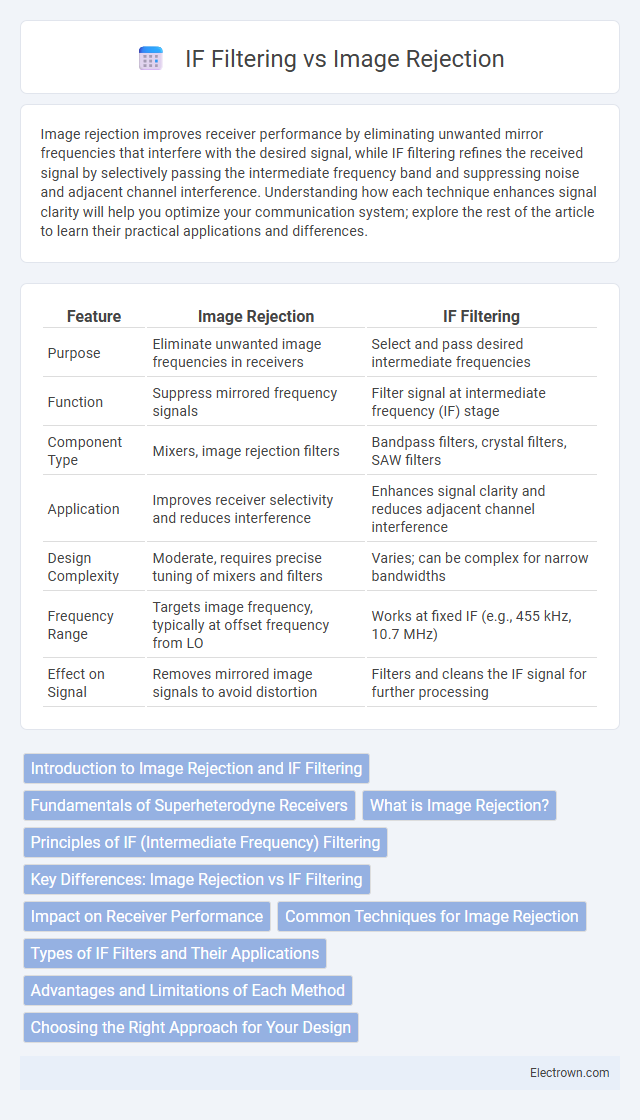Image rejection improves receiver performance by eliminating unwanted mirror frequencies that interfere with the desired signal, while IF filtering refines the received signal by selectively passing the intermediate frequency band and suppressing noise and adjacent channel interference. Understanding how each technique enhances signal clarity will help you optimize your communication system; explore the rest of the article to learn their practical applications and differences.
Table of Comparison
| Feature | Image Rejection | IF Filtering |
|---|---|---|
| Purpose | Eliminate unwanted image frequencies in receivers | Select and pass desired intermediate frequencies |
| Function | Suppress mirrored frequency signals | Filter signal at intermediate frequency (IF) stage |
| Component Type | Mixers, image rejection filters | Bandpass filters, crystal filters, SAW filters |
| Application | Improves receiver selectivity and reduces interference | Enhances signal clarity and reduces adjacent channel interference |
| Design Complexity | Moderate, requires precise tuning of mixers and filters | Varies; can be complex for narrow bandwidths |
| Frequency Range | Targets image frequency, typically at offset frequency from LO | Works at fixed IF (e.g., 455 kHz, 10.7 MHz) |
| Effect on Signal | Removes mirrored image signals to avoid distortion | Filters and cleans the IF signal for further processing |
Introduction to Image Rejection and IF Filtering
Image rejection is a critical technique in radio frequency systems that minimizes interference caused by unwanted mirror frequencies, enhancing signal clarity and receiver performance. Intermediate Frequency (IF) filtering involves selectively passing a desired frequency band while attenuating others, providing improved selectivity and sensitivity in communication devices. Both methods are essential for reducing noise and distortion, ensuring accurate signal processing in modern RF and communication systems.
Fundamentals of Superheterodyne Receivers
Image rejection and IF filtering are crucial in superheterodyne receivers to minimize interference and improve signal clarity. Image rejection involves eliminating unwanted mirror frequencies that appear due to the mixing process, while IF filtering selectively passes the desired intermediate frequency signals. Effective combination of these techniques enhances receiver sensitivity and selectivity, ensuring accurate demodulation and reducing noise.
What is Image Rejection?
Image rejection is the process used in radio receivers to eliminate unwanted signals known as image frequencies that can interfere with the desired signal. These image frequencies occur at a frequency offset equal to twice the intermediate frequency (IF) from the desired input, causing distortion if not properly suppressed. Effective image rejection improves receiver selectivity by using circuits like RF filters or mixers designed to minimize these interfering frequencies before IF filtering.
Principles of IF (Intermediate Frequency) Filtering
IF filtering is essential in radio receivers to selectively pass desired signals while suppressing nearby unwanted frequencies, improving overall signal clarity. It operates by converting the received radio frequency to a lower, fixed intermediate frequency, where precise and stable filters can be applied for enhanced selectivity and sensitivity. Your receiver's performance heavily depends on the quality and design of these IF filters, as they determine the effectiveness of image rejection and signal fidelity.
Key Differences: Image Rejection vs IF Filtering
Image rejection involves eliminating unwanted mirror frequencies in a receiver to prevent interference, typically using mixers and phase shift techniques. IF filtering focuses on selectively passing the desired intermediate frequency signal while blocking adjacent frequencies to improve signal clarity and selectivity. The key difference lies in image rejection targeting mirror image signals before IF conversion, whereas IF filtering operates on the frequency-converted IF signal to enhance filtering performance.
Impact on Receiver Performance
Image rejection significantly improves receiver performance by reducing interference from unwanted mirror frequencies, allowing accurate signal detection and minimizing false demodulation. IF filtering further enhances selectivity by narrowing the bandwidth and attenuating adjacent channel signals, leading to better signal-to-noise ratio and reduced distortion. Together, these techniques optimize sensitivity and dynamic range, crucial for robust communication system operation.
Common Techniques for Image Rejection
Common techniques for image rejection include the use of image-reject mixers and bandpass filtering to suppress unwanted image frequencies during frequency conversion. Double or triple conversion superheterodyne receivers employ multiple intermediate frequency (IF) stages with carefully chosen IF frequencies to enhance image suppression. Surface Acoustic Wave (SAW) filters and cavity filters are often utilized in the IF stage to provide precise selectivity and reject image signals effectively.
Types of IF Filters and Their Applications
Types of IF filters include crystal, ceramic, surface acoustic wave (SAW), and digital filters, each designed to enhance image rejection in radio frequency receivers. Crystal filters provide high selectivity and stability ideal for narrowband communication, ceramic filters balance cost and performance for commercial applications, and SAW filters offer wide bandwidth with compact size suitable for mobile devices. Digital IF filters enable programmable flexibility and precise control, making them essential for software-defined radio systems requiring adaptive image rejection.
Advantages and Limitations of Each Method
Image rejection improves signal quality by eliminating unwanted mirror frequencies before mixing, enabling cleaner output and better selectivity but often requires complex circuit design and precise component matching. IF filtering provides sharp frequency discrimination after mixing, offering flexible and tunable filtering with high selectivity, though it is limited by potential distortion and noise introduced during frequency conversion. Combining both methods maximizes interference suppression but increases system complexity and cost.
Choosing the Right Approach for Your Design
Selecting the optimal method between image rejection and IF filtering depends on your design's frequency range, complexity, and sensitivity requirements. Image rejection techniques work best when you need to minimize interference from unwanted frequencies before signal conversion, enhancing overall receiver selectivity. IF filtering provides more precise control during intermediate frequency stages, improving signal clarity but often requiring more complex circuitry and higher power consumption.
Image Rejection vs IF Filtering Infographic

 electrown.com
electrown.com